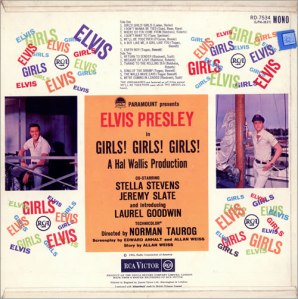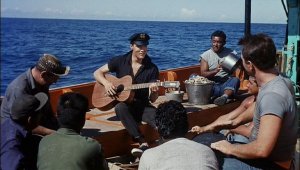
Look closely at the back side of this Girls! Girls! Girls! soundtrack album, and you will see the name of veteran producer Hal B. Wallis who made his name at Warner Bros with such classic films as Yankee Doodle Dandy, Now Voyager, and Casablanca. Wallis finessed an agreement with Elvis’s manager Colonel Tom Parker to produce many of the King’s films at Paramount which, in the early to mid 1960s saw heady profits as the home base for both Elvis and Jerry Lewis. Nice work if you can get it. Meanwhile, Wallis sunk his earnings from the Elvis flicks into fancy prestige projects as Becket and Anne of the Thousand Days.
Anyone who grew up in the 1950s or ’60s, possibly the ’70s, maybe even the ’80s, most likely watched an Elvis Presley movie or two, probably more, either at the movies–and that includes drive-ins–or on TV. A lot of the latter for sure. Per the IMDb, between 1956’s Love Me Tender and 1969’s Change of Habit (w/Mary Tyler Moore as a nun of all things), Elvis made a total of 31 feature films. He was in the military for part of that stretch in the ’50s, meaning most of the films were made in the 1960s. As popular as they were, a lot of Elvis’s movies were awful: formulaic, rushed through production–sometimes as many as three a year–and increasingly filmed on the cheap in order to maximize profits. Even so, we all have our favorites and not without reason. For example, Jailhouse Rock features that amazing musical number featuring the title track while the generally acclaimed King Creole boasts no less than Casablanca‘s Michael Curtiz sitting in the director’s chair and source material by Harold Robbins.
When I was a child I was crazy about Fun in Acapulco, which I first remember seeing in a theatre, though Viva Las Vegas long reigned as my absolute favorite. What’s not to love, right? Elvis meets Ann-Margret in one of the most smokin’ hot romantic pairings in screen history: she sizzles, he smolders. These two really brought out the best in each other, especially when singing and dancing though Elvis’s fiercely protective manager, Colonel Tom Parker, kept Ms. Margret in-check on that count lest she upstage Mr. Presley; after all, Elvis was somewhat out of his comfort zone, working for MGM rather than Paramount, per usual. Plus, Viva Las Vegas was directed by George Sidney, who catapulted Ann-Margret to major stardom with 1963’s Bye Bye Birdie, so, yes, the colonel micro-managed the production from behind the scenes in order to protect his star’s rep. Still, even with limited interaction in musical sequences, Elvis and A.M. are sexy as all get-out. In spades. Yet as fab as Ann-Margret and the King were, they only made one film together, no doubt the doing of Colonel Parker though the two stars remained close throughout the years.
Elvis’s most frequent leading lady was no less than popular TV star and sometime pop-singer Shelley Fabares. Famous for her role on The Donna Reed Show and her #1 hit, “Johnny Angel,” Fabares shared the screen with Elvis three times: Girl Happy, Spinout, and Clambake. Clearly, they enjoy rapport though the movies aren’t anything special, but at least Fabares fared better than the likes of such co-stars as Moore, Nancy Sinatra (Speedway), and Mary Ann Mobley (Harum Scarum), the latter being the dregs of the dregs.
Meanwhile, I have a soft spot for Blue Hawaii mainly because I practically melt when I hear “Can’t Help Falling in Love with You,” which a dear friend sang–beautifully–when I was escorted down the aisle at my wedding oh so many years ago. Of course, one surprising downside is that the Academy snubbed that particular tune while Grammy voters found the soundtrack worthy of a nod. Another downside to Blue Hawaii is that poor Angela Lansbury was barely 10 years older than Elvis when she was cast as his mother, so there’s a casting credibility issue. Luckily, Lansbury redeemed herself from that thankless task by going for the gusto as Laurence Harvey’s politically ambitious mother in The Manchurian Candidate though, wait for it, Lansbury was only three years older than Laurence Harvey, the man who played her son; she then set her sights on Broadway with Mame, and the rest is history, but I digress. Still, Blue Hawaii was a major success and cast the mold for Presley’s subsequent films: exotic locales, fun in the sun, lots of girls, and plenty of music. Indeed, Blue Hawaii was followed in short order by Girls! Girls! Girls!, which like its predecessor was filmed on location and followed the now familiar formula.
So it came to pass that in the deepest darkest days of this past winter, Michael and I happened upon Girls! Girls! Girls! one night, presumably on Turner Classic Movies, and I was instantly captivated. By an Elvis movie. Oh sure, I’d seen it as child (probably at a drive-in), and I easily remembered parts of it, but I had no memory of how revved up with color it was, and is. I mean this is one bright sunny movie, perfect for obliterating winter doldrums, but also a nice summer lark after a long day at the office. See, as I watched that frosty winter evening, I also turned to the IMDb to learn some behind-the-scenes particulars, and what I found is that Girls! Girls! Girls! is in fact the only Elvis movie, the only one, to ever be nominated for a Golden Globe, and, yes, that surprised me. Oh, okay, it’s not like a Globe is the same thing as an Oscar, everybody knows that, but I also thought that Elvis’s popularity would render a Globe nod a no-brainer, especially for some of the classier entries, such as Viva Las Vegas, King Creole, Flaming Star, and a precious few others.
To clarify, in the case of Girls! Girls! Girls!, the GG nomination was for the film as a whole: Best Motion Picture Musical; not surprisingly, it lost to The Music Man in a competition that also included Gypsy and Billy Rose’s Jumbo (starring Doris Day), all of which I actually enjoy. To further clarify, Elvis’s name frequently appeared on the Laurel award honor roll, voted by theatre owners and managers via the trade mag, Motion Picture Exhibitors: second place for Girls! Girls! Girls!; third place for Viva Las Vegas. He actually won for Tickle Me, the only acting award of his career. Really? I fully confess that I used to watch Tickle Me whenever it aired on the old late show, and enjoyed it immensely as a kind of mystery/comedy even though it retains a large cheese quotient. (Backing up to Blue Hawaii, it finished 4th in the Laurel voting for Best Musical.)

Elvis (center) and Girls, Girls: Stella Stevens (l) and Laurel Goodwin (r), both of them gorgeous in dresses designed by legendary Edith Head
Back to Girls x 3. What’s so special about this one? First, as noted, the colors provide an amazing and welcome sensory jolt, and by the colors, I really mean one color specifically, blue: blue skies, blue waters, and even co-stars Laurel Goodwin and Stella Stevens attired in shockingly blue outfits–designed by no less than the illustrious Edith Head [1]. Even the doors in Elvis’s rival’s office are intensely blue. Right? It’s like Blue Hawaii only bluer. The cinematography, btw, is credited to no less than Loyal Griggs, a multiple Oscar nominee and, in fact, a winner for 1953’s magnificent Shane [2].
Interestingly, and in contrast to Fun in Acapulco, Elvis ventured to Hawaii for the shoot. Apparently, security concerns kept him from making the trip to sunny Mexico for the later movie. Now, this is important because Fun in Acapulco is clearly cobbled from location shots with stunt doubles (or a stunt double), and studio trickery including some obvious process shots, also known as rear projection, also known as the precursor to blue and green screen technologies [3]. Oh, there are still plenty of process shots in Girls! Girls! Girls! as Elvis’s character spends plenty of time in a fishing boat out on the water; however, there is just enough of actual location footage to help suspend disbelief, especially since the process stuff is actually pretty clever, almost seamless, compared to, say, the same era’s Beach Party flicks, some of which were also directed by Norman Taurog [4]. The process shots are also more persuasive than those of Elvis and Ann-Margret water-skiing in Viva Las Vegas, which are kind of obvious and lame.

Process shot or actual location footage? In Girls, Girls, Girls, filmed in Hawaii, it isn’t always easy to tell.
Girls! Girls! Girls! also contains a couple of swell musical numbers. A lot of the songs in Elvis movies are and were forgettable, mere filler to justify a soundtrack album as well as to compensate for skimpy scripts. Oh, there are a few such lackluster ditties in G!G!G!, but two in particular rise above the rest. First and foremost would have to be “Return to Sender,” a genuine Elvis classic that was actually recorded for the film (as opposed to a convenient retread). The other number is an especially imaginative tango, of all things, set in the teeny bachelorette apartment of Presley’s newest squeeze, played by Laurel Goodwin. The whole scene is a pip because Elvis actually prepares and serves dinner even though it’s the girl’s place, but that’s just the beginning. Presley and Goodwin cap their evening with the ingeniously conceived “The Walls Have Ears,” which finds the pair dancing amid noisy neighbors and rattling walls. Truly, it must be seen to be believed, and I won’t spoil it by including a clip. Go find it and watch it for yourself. You’ll probably be delighted in a way you might not have imagined–especially if it’s been 20, 30, or 40 years since you last saw it. Credit for the staging of this ditty belongs to choreographer Charles O’Curran whose credits include G.I. Blues, also with Presley, and Bells are Ringing.

Return to Rio: My favorite movie of the summer, so far, is Rio 2. Okay, technically, I know it was released in April, but I didn’t see it until it hit my neighborhood discount house last month, and I’ve actually seen it twice. Oh, and I never even saw the first one, don’t know why, but when I saw the trailer for the sequel, I was blown away. Why? Well, just like Girls! Girls! Girls!, Rio 2 is just insane with color, maybe the most intense, color-rich animated movie I’ve seen since Fantasia. Michael compared it favorably to Yellow Submarine. The story is a little perfunctory, but, this non-Disney/Pixar flick offers some pleasing musical numbers. (The original featured the Oscar nominated “Real in Rio,” co-written by Sergio Mendes) Coincidentally, this cartoon creature feature includes a rainy, late night scene reminiscent of such a scene in Girls! Girls! Girls! Oh, this one is available for home video this coming Tuesday: 07/15. Check it out! Btw: #2 on my list of summer faves is Jersey Boys, which I also hope to see again soon.
So, when I ask myself, what was it about Girls! Girls! Girls! that prompted the Hollywood Foreign Press to nominate it for Golden Globe–after I rule out bribes by the suits at Paramount–the answers I find most satisfactory are the lush cinematography and/or production values, and a few nifty musical numbers. Plus, the movie was a big hit, of course. Also, Elvis works hard to give a real performance. What’s that, you say? I’ve spent the past week or so reading reviews of ALL Elvis movies by a number of seasoned Elvis fans/bloggers, and one frequent complaint is that he plays a character who is quite unlikeable at times. Yes, I agree. His “Ross Carpenter,” a down on his luck fisherman with both girl troubles and money woes, isn’t always nice, and what a great challenge for Elvis or any actor. How did the Colonel let this one get past his Elvis image gauge? In many movies, Elvis played characters that seemed stamped out of cardboard, characters that seemed to exist only to curry favor with audiences as though Presley could not manage that on his own. Another favorite scene, set on a lanai during a late night rainstorm, shows a softer side of Elvis, a sweetness and vulnerability that didn’t find its way into his later movies. Another plus.
Of course, we’re still in the fantasy realm of Elvis, not, say, Lawrence of Arabia, To Kill a Mockingbird, The Longest Day, The Miracle Worker, or The Manchurian Candidate, all of them released the same year. One of the most glaring flaws is, of course, racism in the form of exoticizing the locals, especially a pair of sisters–wee youngsters of Chinese descent. Played by real-life siblings, Elizabeth Tiu and Ginny Tiu, these are some adorable moppets, but their very “differentness” seems exaggerated to the point of rendering them as barely more than show-biz pets or dolls if you get my drift, something less than human. You know, the way clumsy American tourists make a fuss over “native” children. At any rate, what played as cute in the early 1960s registers most differently in a presumably more culturally enlightened era though, to clarify, it’s not Elvis, per se, who treats the girls condescendingly; it’s the filmmakers who are to blame. Oh, well, at least the girls get to do something. Not so Stella Stevens, wasted in the nothing role of a catty one-time fling, that is, ex-fling, who just can’t seem to let go. She drains the energy out of almost every exchange but puts over a sultry night club number or two, and she looks swell. Goodwin hardly fares better. She’s a good sport, but she lacks pizzazz. It’s no wonder that, per the IMDb, her acting career was relatively short-lived.
Poor Elvis. Well, sort of. He truly was a victim of his own success. Reportedly, he hated many of his own films and yearned for a chance to prove he had it in him to be a great film actor rather than a merely passable one. The trouble wasn’t really with him but rested with that damn Colonel Parker. The legend is that Elvis was considered for the male lead in 1961’s blockbuster adaptation of West Side Story, but the colonel didn’t feel it was the right vehicle for his star, what with gangs and knives–not to mention the fact that Elvis would have had to share the screen with a huge cast of actors, singers, and dancers that might have pulled focus. Nothin’ doin’. Of course, West Side Story was a box office blockbuster that also scored big at the Oscars, taking awards in 10 categories, including Best Picture and Best Director–shared, in an Academy first, by Robert Wise and Jerome Robbins (though the latter, hired specifically for the dance sequences, was dismissed midway through production, but I digress). Several years after quitting films with Change of Habit, Elvis was approached as a possibility to play the doomed rock star in Barbra Streisand’s remake of A Star is Born, but, once again, Parker intervened on behalf of his client, reportedly with a list of demands that did not set so well with Babs who was also one of the film’s producers. Instead, the role went to rugged country singer-songwriter and sometime actor Kris Kristofferson who at least temporarily reinvented himself as a sexy leading man. A year after A Star is Born, Elvis passed away at the age of 42. Only 42, a legend in his time, no doubt, but also a study in unrealized potential and a mass of contradictions. Maybe he could have built on the potential he showed in his early films, but he allowed himself to be manipulated by someone who stubbornly resisted opportunities for real growth.
Still, as Girls! Girls! Girls! proves, not all of Elvis’s many, MANY, films were mindless failures. Indeed, as I came home today to finish the article, I turned on the TV and found King Creole on the second or third channel I selected, most likely TCM yet again. More good stuff, including gorgeous black and white cinematography, New Orleans location footage, and a fascinating sequence set in the rain. As much a treat in the summer as Girls! Girls! Girls! was in the winter. Maybe it really is good to be the King after all.
Thanks for your consideration…
Elvis at the Internet Movie Database http://www.imdb.com/name/nm0000062/?ref_=nv_sr_1
[1] For the uninitiated, in her illustrious career Head racked up a whopping 35 Oscar nods (in both color and black & white categories), taking home a total of 8 statuettes, a record for both a woman and a costume designer. Her detractors insist that, as the longtime head of Paramount’s costume department, she often took credit for work that wasn’t hers. Her Oscar winners include The Sting, All About Eve, Samson and Delilah, The Facts of Life, and A Place in the Sun. Among the films for which she was nominated for but did not win is the Shirley MacLaine extravaganza, What a Way to Go!
[2] Griggs was previously included in the piece, “Goodbye, Yellow Brick Road…” from December 30, 2013.
[3] In other words, actors performing before a pre-filmed “plate ” to simulate the effect of riding in cars, surfing, or any other outdoor activity that presents filming challenges.
[4] Among Taurog’s nearly 200 credits are 1931’s Skippy, for which he won an Oscar, as well as Boys Town (1938). He might have directed portions of The Wizard of Oz though uncredited. His filmography also includes some of the Martin & Lewis outings.

